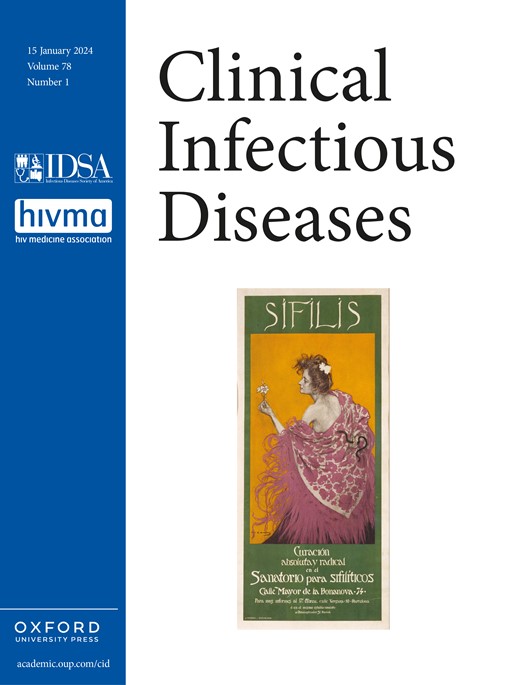Integrase Strand Transfer Inhibitors for Treatment-experienced Young Adults With Perinatal HIV in the US: Immunologic, Virologic, and Anthropometric Outcomes.
IF 7.3
1区 医学
Q1 IMMUNOLOGY
引用次数: 0
Abstract
BACKGROUND The efficacy of integrase strand transfer inhibitors (INSTIs) among adults with HIV is well-established, though adverse effects, particularly weight gain, are common. Comparable data for treatment-experienced adolescents and young adults with perinatally-acquired HIV (AYAPHIV) are limited. METHODS AYAPHIV in the US-based Pediatric HIV/AIDS Cohort Study who switched to bictegravir (BIC), dolutegravir (DTG), elvitegravir (EVG), or raltegravir (RAL) from any prior regimen were eligible. Using mixed-effects models, viral load, CD4 count, weight, and body mass index were described through 2 years after switch for each INSTI. RESULTS Among 556 AYAPHIV, there were 167 switches to BIC, 282 to DTG, 189 to EVG, and 151 to RAL. Viral suppression (<200 copies/mL) at 1 and 2 years after switch was 74% and 69% for BIC, 62% and 60% for DTG, 76% and 68% for EVG, and 58% and 52% for RAL. Mean CD4 counts were above 500 cells/mm3 after switch through 2 years for all INSTIs. Average weight gain in the first year after switch to BIC, DTG, EVG, and RAL was 0.2, 2.5, 3.8, and -0.2 kilograms for females and 2.3, 4.8, 2.9, and 2.6 kilograms for males. Among previously underweight/healthy individuals, 13%, 18%, 36%, and 12% of females and 6%, 8%, 12%, and 11% of males switching to BIC, DTG, EVG, and RAL were overweight/obese by 2 years after switch. CONCLUSIONS Individual INSTI-based regimens among treatment-experienced AYAPHIV had moderate effectiveness with respect to viral suppression. Continued average weight gain across INSTIs raises concerns about long-term cardiometabolic sequalae.整合酶链转移抑制剂在美国治疗经历过围产期HIV的年轻人:免疫学、病毒学和人体测量学结果。
背景:整合酶链转移抑制剂(iniss)对成年HIV感染者的疗效是公认的,尽管副作用,特别是体重增加是常见的。接受过治疗的青少年和年轻围产期获得性艾滋病毒(AYAPHIV)患者的可比数据有限。方法sayaphiv在美国儿科HIV/AIDS队列研究中,从任何先前的方案切换到比替格拉韦(BIC)、多替格拉韦(DTG)、依利韦(EVG)或雷替格拉韦(RAL)是符合条件的。使用混合效应模型,在每个INSTI转换后的2年内描述病毒载量、CD4计数、体重和体重指数。结果556例AYAPHIV中,167例转为BIC, 282例转为DTG, 189例转为EVG, 151例转为RAL。转换后1年和2年的病毒抑制(<200拷贝/mL), BIC为74%和69%,DTG为62%和60%,EVG为76%和68%,RAL为58%和52%。2年后,所有iniss患者的平均CD4计数均高于500个细胞/mm3。在改用BIC、DTG、EVG和RAL后的第一年,女性的平均体重增加为0.2、2.5、3.8和-0.2公斤,男性为2.3、4.8、2.9和2.6公斤。在之前体重过轻/健康的个体中,13%、18%、36%和12%的女性以及6%、8%、12%和11%的男性在转换为BIC、DTG、EVG和RAL后的2年内超重/肥胖。结论在已接受治疗的AYAPHIV患者中,以个体免疫球蛋白为基础的方案在病毒抑制方面具有中等效果。持续的平均体重增加引起了对长期心脏代谢后遗症的担忧。
本文章由计算机程序翻译,如有差异,请以英文原文为准。
求助全文
约1分钟内获得全文
求助全文
来源期刊

Clinical Infectious Diseases
医学-传染病学
CiteScore
25.00
自引率
2.50%
发文量
900
审稿时长
3 months
期刊介绍:
Clinical Infectious Diseases (CID) is dedicated to publishing original research, reviews, guidelines, and perspectives with the potential to reshape clinical practice, providing clinicians with valuable insights for patient care. CID comprehensively addresses the clinical presentation, diagnosis, treatment, and prevention of a wide spectrum of infectious diseases. The journal places a high priority on the assessment of current and innovative treatments, microbiology, immunology, and policies, ensuring relevance to patient care in its commitment to advancing the field of infectious diseases.
 求助内容:
求助内容: 应助结果提醒方式:
应助结果提醒方式:


